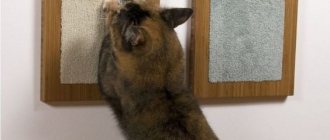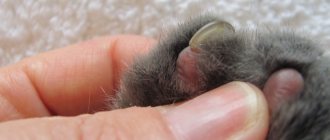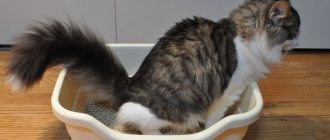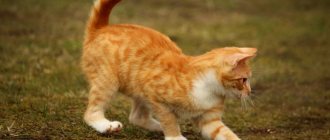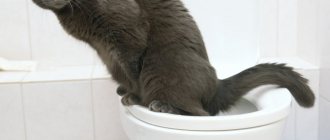Why does a cat tear up furniture?
Cats are used to sharpening their claws. They have no intention of ruining things. The cat sharpens its claws to remove dead particles, smooth the surface and sharpen the tips. This is a kind of exercise for the paw muscles. Surely the owners have noticed how the pet stretches sweetly after waking up and extends its claws to cling to something nearby.
Cats mark their territory this way. The glands located on the paw pads exude a characteristic secretion, the aroma is felt only by animals. Performing a daily “ritual,” cats strive to reach the top mark with their paws in order to create the appearance of a large and scary predator that left this mark.
A scratching post is a useful accessory that can protect furniture and wallpaper from cat attacks. However, in practice, teaching a pet to stand is much more difficult than, for example, teaching a pet to relieve itself in a litter tray. After all, this process involves confrontation with nature itself and is equivalent to training a cat.
The role of the scratching post
Domestic cats tear up furniture and carpets not because they want to harm their owner. For them, this is a natural process that completes awakening.
Cat claws periodically fall out and are replaced by new ones. Removal of old claws occurs precisely during scratching of furniture. This process allows not only to neutralize, but also to shorten the necessary claws.
If your pet cannot sharpen its claws, it will have to chew them off on its own. This is fraught with damage to the phalanx and the introduction of pathogenic microorganisms into the wound.
Also, damage remaining on the surface of objects serves as a mark for strangers, signaling that the territory is already occupied.
To minimize the negative consequences of keeping a cat in the house, you need to buy a special device - a scratching post or drag.
What measures should not be used when training a cat?
You cannot hit or scream at your cat if it has once again tested the strength of the sofa. The pet will be scared, but it is unlikely to understand why they are angry with him. It’s better to say sternly: “You can’t,” and hit the floor with a slipper or clap your hands. The animal will be wary and understand that this is not worth doing.
Attention! Cats are vindictive by nature. For any aggression in their direction, they are ready to commit meanness. If you yell at her or hit her, for example, she may relieve herself on the bed.
You should not spray your cat with water from a spray bottle when it begins to sharpen its claws. Of course, contact with water is unpleasant for a pet, which means contact with a carpet, sofa or something else into which its claws have previously dug will be associated with danger that should be avoided. However, this method can hardly be called humane.
Important! Sometimes cats sharpen their paws not because they feel the need. They strive to attract attention because they remember that after damage to furniture or a carpet, people start yelling at them.
Where to place the scratching post?
We recommend placing the accessory in places where your pet usually likes to sharpen its claws. If your pet friend sharpens his claws on a chair or door, then place a post nearby. If the animal prefers to sharpen its claws on the carpet, place the product horizontally. As soon as the four-legged animal understands why the sharpener is needed and begins to use it, the scratching post can be moved to a place convenient for you.
Horizontal models are best left near the place where the cat sleeps, eats or plays. After sleep, animals like to stretch their legs and sharpen their claws. If the product is located next to the tailed one, it will not scratch the furniture on its way to the sharpener. This way he will fully wake up and quickly mark his territory. After the tailed cat eats, he most often wants to play and run. A sharpener with a toy located near the kitchen will help the cat burn off energy and have fun.
Look at the place where the cat usually sharpens its claws
How to accustom a kitten to a scratching post
The first steps in the process of accustoming a cat to a scratching post should be arranged in a certain order.
- Introducing the scratching post. You need to attract the kitten's attention to the scratching post in a playful way. You should stand near the accessory and tease your pet with a moving toy or any other object that can arouse the animal’s interest. The kitten will play around and wrap its paws around the scratching post.
- After waiting for this moment, the owner can quietly scratch the counter with his nails. The animal will hear the sound and may want to join in exploring the new thing.
- If, after the above-described manipulations, the kitten does not understand the purpose of the accessory, it is necessary to place the scratcher in a horizontal position and play with the animal around it. The cat will probe the surface with its paws when it accidentally jumps onto the scratching post while hunting for a toy. After a while, the pet will begin to use the nail clipper without the owner’s prompting or help.
- As soon as the animal develops the skill of sharpening its paws on a special stand, the scratching post can be returned to its original position, more convenient for the owner.
The best effective method of training a scratching post is to play with the kitten near the counter.
Like many other manipulations with animals, this habit is best developed at a tender age. Especially if the kitten tried to copy its mother and repeated the same actions after her. Therefore, it is good when the baby’s parents are already accustomed.
Tips for training a scratching post
10 effective tips that will lead you to success:
- Offer your cat different models (by location, texture). This way you will find one that the animal likes.
- Move the scratching post around until you find a spot that interests your cat the most.
- Patiently repeat the attempts, bringing the cat to the scratcher several times a day. Try to catch the moment when the animal just woke up. After sleep, most cats stretch and scratch with their claws.
- Purchase several models of different textures and orientations (horizontal, vertical, angular, oblique). The cat must have a choice.
- If a cat scratches its claws in the wrong place, you need to strictly tell it “no”, teaching it to the command, and take the pet to a place where it can scratch. Screaming and being an animal is unacceptable!
- Choose a model of the correct height. The cat must be able to stretch its spine - this is one of the reasons for scratching. Models that are too low are not suitable for this.
- Start training to use a nail clipper from a very early age.
- Make sure the fastening is secure. Buy models with a stable base or attach it to the floor. Cats are afraid of scratching posts that swing under the weight of the animal.
- For each animal in the house there should be at least two places for sharpening claws.
- Treat all scratchable surfaces with synthetic pheromones.
Six effective tips
Below are some helpful tips that will help you succeed in training your kitten to use a scratching post:
- Encourage your petwhen he independently approaches the counter and begins to cling to it with his claws. You can praise, pet or give a treat.
- Do not grab your pet by the paws and force him to scratch the scratching post. Even if the owner does this carefully and gently, the kitten still will not understand what they want from him. He won't like it. The animal will try to escape from your hands, and the scratching post will already be associated with something unpleasant
- Try to attract your cat with mint. Do not use valerian (valerian), it, like a drug, distorts behavior and dulls the cat's instincts. Take a small amount of catnip and sprinkle (spray) the counter. This product attracts cats well, they begin to rub, purr and release their claws with pleasure.
- When playing near the counter, be attentive and consistent in your actions so that your pet clearly understands what they want from him.
- Do not play with the animal near curtains or furniture. By grabbing an object, the kitten will think that it can scratch other nearby things.
- Cover the corners of the sofa and other furniture with something rustling, such as bags or foil, while training you to use the scratching post. If a cat pulls up the carpet, it should be removed until a useful skill is finally established in the pet’s behavior.
For kittens, it is recommended to buy horizontal scratching posts in the form of boards trimmed with jute or sisal. Wooden ones are not the best option at a tender age, since the paw pads of small pets are too soft and susceptible to mechanical damage.
How to teach a kitten to sharpen its claws
The younger the kitten, the easier it is to train him. Kids quickly grasp everything and develop habits.
To ensure your kitten understands what you want from him, be consistent in your actions and be patient. Next, we will tell you step by step how to accustom a kitten to a scratching machine.
Step 1 Choose a scratching post
One important rule applies here - you choose not for yourself, but for your pet. There is no need to select this item to match the interior design of the apartment, choose models that visually appeal to you. If the kitten doesn't like the scratcher, the owners are doomed to failure.
- Give preference to tall models. The cat should be able to stretch and scratch as high as possible.
- If you bought a wall-mounted model of a scratcher, hang it so that while standing on its hind legs, the cat can fully extend its front legs over its head.
- Buy sustainable models. If the kitten feels that the scratching post is wobbly or shifting, he may become afraid and refuse to use it.
- Choose a texture that your pet will like. If the kitten likes to scratch the carpet, carpet options are suitable. If you're not sure what's right, try scratching posts with natural rope wrapped around a pole or corrugated cardboard models.
- Avoid models made of synthetic fibers and ropes, they create static electricity, which repels cats.
- Give your pet the opportunity to choose, purchase several accessories with different textures.
We recommend reading the article about which scratching post for cats to choose.
Step 2 Restrict access
Limit the animal's access to the areas it chooses to sharpen its claws.
- Cover upholstered furniture (sofas and armchairs) with covers, a heavy blanket or plastic wrap.
- Remove carpets or treat them with a citrus-scented spray; cats don’t like it.
- Wrap the scratched area with food foil or double-sided tape. Animals find it unpleasant to touch foil and sticky surfaces.
- Before leaving home, close rooms with upholstered furniture that the pet has chosen for sharpening its claws.
- Place the claw clipper directly in front of the object that the kitten likes to scratch.
Step 3 Choose a location
Choosing the location of the nail clipper is an important step in the training process. Scratching posts should be placed in areas suitable for cats. There is no need to put them in a corner or hide them in hard-to-reach places. This is convenient for owners, but cats will not like it. Place it where it is convenient for your cat to use it as a “territory marker.”
- Place it at the front door, under the window and in the place where the pet has chosen the place for sharpening its claws.
- If your cat likes to stretch and sharpen its claws after waking up, place a horizontal nail polisher where the cat likes to sleep.
- Watch the animal. If it sharpens its claws on vertical surfaces, place the nail clipper vertically. If your pet likes to sharpen its claws on carpets, place a horizontal model.
Place several scratching posts in different places. This will make it more likely that your cat won't touch your furniture or rugs.
Step 4 Increase Interest
The last step is to increase interest and draw attention to the scratching surface.
- To attract your cat to a new object, you can spray the scratching post with special training agents.
- You can increase the attractiveness of a new item for a cat with the help of valerian. A few drops of the product are enough to smear on the scratching post.
- Catnip has a similar effect, the smell of which drives kittens and adult cats crazy. Simply sprinkle dried mint on the base and top of your nail clipper.
- Engage with games and toys. Play with your kitten next to the scratching post. Decorate it with feathers or light balls for your pet to play with. So, during the game, the baby will understand that this object is convenient for sharpening his claws.
- Try placing the column sharpener on its side. This will make it easier for little kittens to get to know her. When they get used to it, place the post vertically.
- Praise your cat every time he uses this item for its intended purpose.
- Offer your pet's favorite treat when he places his paws on the nail sharpening surface. Give a treat every time the kitten sharpens its claws in the right place. Treats will help create a positive mood in the animal and the training process will go faster.
- You can attract attention by borrowing this cat accessory from your friends. The kitten will smell someone else's smell and will try to interrupt it by scratching the surface that retains the smell of another animal.
- Gently place your kitten's paws on the scratching surface and make a scratching motion. Be calm at this moment, speak kindly to the kitten.
The more often the kitten scratches the scratching post, leaving its smell, the more attractive this item will become for the pet.
How to train an adult cat
Adults are smart, just like kittens, so the process of accustoming to a scratching post will not take longer. You need to act as in the case of a kitten:
- Bring your pet to the counter; in this case, you can move its paws along the upholstery of the scratching post.
- If necessary, use additional motivation - play a toy with her, moving the mouse or feather along the surface.
- You can, as in the case of a kitten, rub the upholstery with catnip leaves, the main thing is not to overdo it, cats have a keen sense of smell and a pungent smell can scare off the pet.
Important! If the previous tips turned out to be ineffective, you can rub the surface of the counter with a rag that you previously stroked a strange cat. The animal, sensing someone else's scent, will begin to mark the territory using its claws. However, it should be remembered that cats can mark in a slightly different way. If urine gets on the scratching post, a clean cat will most likely refuse to sharpen its claws on it in the future.
Why do cats sharpen their claws?
Some cat owners do not understand why cat sharpeners are needed and believe that this is pampering.
However, pets need this for several reasons:
- The main one is the removal of dead areas. To do this, pets need a hard surface or a hard roller. After sharpening, the claws become sharp and short. This helps in easy movement. In addition, claws are also a pet’s weapon.
- Marks territory. A special liquid forms on the cat's pads, which is called secretion. It is secreted by glands. Only animals can smell the liquid. The secretion is released only when the claws scratch and release them. Cats are naturally designed to mark their territory. They do this with the help of a secret, notifying that this place is occupied. Since the liquid is odorless and colorless, it is invisible to people. However, it is important for a pet to indicate its rights, especially if there are other animals in the house.
- A cat may sharpen its claws out of boredom or as a form of exercise. Thus, it strengthens the back muscles, shoulder joints, and limbs. This activity is especially necessary after a long sleep.
Sometimes he sharpens his claws to attract attention to himself, out of anger or boredom. In this way, the pet attracts attention to itself, especially if the lining suffers. If there is a special device, it will save the furniture.
What will help attract a cat to the scratching post?
To attract your pet to the scratching post, you first need to wean it from sharpening its claws in the usual way, that is, on furniture, wallpaper, etc.
- Will help scare your pet away from the sofa or carpet sharp citrus smell. Treat your favorite nail sharpening areas with lemon juice. This will keep the animal away from them for a long time.
- Cats do not accept polyethylene , because its surface does not leave the slightest chance for claws to catch on. And the bubble wrap actually creates fear in the cat. Cellophane should be used to cover furniture and places (wallpaper and doors) that the pet has chosen. For these purposes double-sided tape sold in pet stores will do. When a pet wants to sharpen its paws, it will begin to stick to the surface, and cats don’t like that.
- As mentioned earlier, the smell of catnip, toys attached to a scratching post, and rewarding with treats when the cat behaves correctly will help attract a cat.
All protected areas need to find a replacement - a scratching post. You can buy it in a specialized store or make it yourself. It’s better to take or make several and place them in your favorite places, and then begin the training process according to the recommendations described above.
If you can’t train your pet to use a scratching post, you can try the following:
- change the location of the stand, moving it to the corner where the cat is used to getting a “manicure”;
- hang your pet’s favorite toy on the stand (or better yet, a bell or rattle, such things can arouse greater interest in the cat);
- treat the upholstery with catnip powder or solution;
- observe the animal and determine which surfaces it scratches most often: vertical or horizontal and which material is of greater interest. This will help when choosing a scratching post.
Types of devices
The scratching post is sold in almost any pet store. This is a special device designed for sharpening the claws of domestic cats. Today there are the following types of drapes:
- Column. This is the most common model. It is very useful for the animal’s skeleton and muscles, since the pet will be able to climb the base to the very top.
- Little house. It is both a drape and a place to sleep. The role of a scratching post in such a design is usually performed by one of the walls of the home.
- Multi-level play area. It looks like a labyrinth, which consists of columns, ladders and other devices. Here the animal can not only sleep or sharpen its claws, but also actively spend time playing.
Depending on the material, drapes come in the following types:
- cardboard. This is the cheapest device, made of environmentally friendly material that wears out quickly;
- rope Good for sharpening claws;
- wooden. Considered the most durable;
- sisal. In terms of durability, they are almost close to their wooden counterparts.
Also, such devices can be vertical (columns) and horizontal (plates).
Useful video
Video instructions on how to accustom a kitten and an adult cat to a scratching post:
Patience, persistence and regular repetition will help train even the most stubborn pets. There is such a procedure in the world as removal of nail phalanges. However, in many countries it is equated with mutilation and is opposed to these actions, and we are of the same opinion.
If you can’t get your cat accustomed to a scratching post, then you can think about using silicone anti-scratch pads or trim your pet’s claws more often, and our article on proper claw trimming will help you with this.
Everyone is responsible for those they have tamed, therefore, when taking a new animal into your home, it is important to understand all the responsibility and natural needs of pets. Accustoming to a scratching post is a complex process that requires a lot of time, but this is the only option when, as they say, both the wolves are fed and the sheep are safe. Leave comments on the article about what methods you know of training a cat to use a scratching post.
Selection and installation of a scratching post
Smart owners understand that cats obey instincts, and it is a waste of time to scold them for damaging furniture. Observing the preferences and physiological characteristics of the cat will help you choose the right scratching post:
- Watch your pet, take a closer look at how he prefers to sharpen his claws - on a horizontal surface or on a vertical one. Based on your observations, choose a suitable model in the store (mat, column, curved form).
- The size of the fight must correspond to the size of the animal. The scratching post should be such that the cat can stretch out freely while scratching it.
- If the fight is placed unstable, the cat may ignore it. Choose a model with a wide and heavy base.
If you have the time and desire, you can make a scratching post yourself. It will be cheaper, and you can make just such a thing that fits perfectly into your interior.
Types of structures
What types of scratching posts will be functional, fit into the interior, help the cat relieve stress, and help the owners keep their furniture upholstery, shoes and wallpaper intact?
- Vertical
. All versions of floor posts braided with rope are popular due to their small size and structural stability. Vertical columns start from 50 cm (suitable for accustoming a kitten to a scratching post) and are limited only by the budget and the height of the ceilings in the owners’ house. A single vertical column can be easily placed in small spaces to target areas that cats like to pick at.
- Game complexes
from several vertical planes of different levels, with shelves and beds, perhaps with different textures of materials, they take up more space and are more expensive.
- Planks
. The advantages of planks braided with jute, rope, fabric, laces or upholstered in fabric include mobility and small size. They can be used to cover the cat’s favorite place on the wallpaper or furniture.
Whatever scratching post you choose, the main thing is that it copes with the expected tasks and does not just accumulate dust.
Size and material
Observe your cat before purchasing: does she like fabric surfaces or does she manicure on cabinet furniture? Perhaps she liked wood or a completely unusual material? Observation will help you decide on the choice of covering and will eliminate the fact that the animal will ignore the scratching post.
Owners often learn how to accustom an adult cat to a scratching post through trial and error. To avoid them as much as possible, you need to pay great attention to the habits and character of your pet.
You should stock up on patience and treats to reinforce the results.
Offer different materials: strips of corrugated cardboard, balls of woolen thread.
The height and thickness of the scratching post should correspond to the size of the animal. The Maine Coon will not sharpen its claws on a small and unstable board - it simply will not impress him. The opposite situation: it will be difficult for a kitten to peel off a surface with a large weave - it will get caught in its claws and will not be able to get out.
Where to put
If attempts to tear up furniture or a wall have already been made, then it is best to place the scratching post in this particular place. After installing the device, it is better to block off the places of other “attacks” so that they do not attract the pet’s attention again.
It’s good if the cat independently appreciates all the charm of the new item. If the animal does not understand the first time why fighting is needed, continue training until the necessary skill is formed.
After your pet has become familiar with the scratching post and has learned to use it, and you are sure that the bad habit is already a thing of the past, start moving the scratching post. Move it daily, little by little, until it is in the place you have chosen for it.
If the apartment is large or there are several cats in the house, it is useful to purchase not one, but several scratching posts and place them in different places. The best place to place a scratching post is next to the bed. As soon as the cat wakes up and wants to stretch, she will turn to the device.
How to choose?
So, you need to start... with the breed of your pet. Agree that a big cat needs a different scratching post than a small one. And if you know that your pet will grow to the size of a small hippopotamus, there is no point in buying him a small cone-scratching post, he will quickly outgrow it, and the issue will become relevant again.
Unfortunately, a cat scratcher can become an unnecessary dust collector if the cat doesn’t like it. In order for your cat to need it, you should take a closer look at what kind of furniture he breaks more often than others. Or maybe he prefers wallpaper or carpet? In this case, it is better to choose a machine with carpet flooring. If the cat doesn’t have any special preferences, you should choose a floor or corner one so that you can take it with you or rearrange it. And most importantly, it must be sustainable.
It is possible to take a scratching post specifically for a kitten, but you need to understand that as the animal grows, you will need to change the scratching post.
- The rarest cat breeds
- German Shepherd
- What kind of snakes are kept at home?
- Ancient dog breeds
- Dog's sense of smell
- Maine Coon
If you are not sure what size your pet will reach, we recommend that you immediately take a flat, high cat scratching post that is mounted on the wall. Or choose a flat, floor-standing scratching post. This type of device is universal and can be used by both small kittens and large cats.
If you choose the option of combining a scratching post with play complexes or a house, then you solve several problems at once: saving furniture, organizing a place for relaxation and space for games. Today there are a lot of offers of such complexes on the market. We recommend paying attention to the Lapahvost store. Prices for scratching posts and play complexes are among the lowest on the market. Pleasant delivery conditions and constant promotions. Compare and make the choice yourself.
So, you can imagine what kind of cat scratching post you would like. Now you need to choose the material from which it will be made. The most common scratching post models on the market are those with sisal or jute winding. They are environmentally friendly, do not require special care, and cats love this material very much. Scratching posts for large cats have a sisal winding. It holds the weight of the animal well, the cat can climb for pleasure without danger.
There are also carpet scratching posts on the market. Most often they are equipped with fur, toys, and the basis of such a scratching post is carpet. Some cats love to sharpen their claws on this type of covering, and you can save your sofa by purchasing this model.
How to choose a suitable scratching post for an animal?
Sharpening the claws is necessary to maintain the physical and psychological health of the cat, so it is impossible to forbid her to do this, and it is useless. Manufacturers offer many options for this useful device. When choosing, you need to take into account the size of the pet, the characteristics of its behavior, and pay attention to the shape and material from which the scratching post is made.
Pet dimensions
One of the main parameters of the product is its dimensions. The dimensions of a wall-mounted scratching post are calculated as follows: the height is equal to the length of the pet with outstretched paws plus a margin of 10 cm. If the device is purchased for a kitten, you should focus on the dimensions of adults of the same breed. The minimum width of a flat wall product is 40 cm, each corner edge is 25 cm or more. The optimal length of a floor scratching post is 70–100 cm, width – 40–50. The height of the scratching post in the form of a column is at least 70 cm.
How to stop claw sharpening
So, sharpening claws is a necessity for an animal, but a real headache for its owner. There are several ways to save furniture, wallpaper, clothes, magazines and newspapers, curtains, drapes and other items:
- Regularly (1-2 times a month) trim the animal's claws with nail clippers
. It is advisable to carry out this procedure for pets from an early age (from 1-1.5 months). During the cutting process, it is necessary to cut off the curved transparent tip of the nail without affecting the red pulp with nerve endings and blood vessels. You can do a haircut both at home and in a veterinary clinic (where it will cost 100-200 rubles). After a haircut, the pet will be able to scratch, but the damage to furniture (carpets, wallpaper, etc.) will be insignificant. And a pet with trimmed claws will not seriously bite the owner; - In the clinic or at home, special silicone anti-scratch attachments are often put on the animal’s
. Packaging of such anti-scratch pads costs on average from 200 to 500 rubles (the kit includes glue for fixation). Their service life is from 1 to 3 months, depending on the level of activity of the animal. With such soft anti-scratch pads, the cat will be able to sharpen its claws, but without leaving scratches anywhere. The only disadvantage of the attachments is that they need to be glued to each claw, but it is rare that a cat will sit quietly on the owner’s lap during such a procedure; - The problem of scratching can be permanently solved by cutting off the terminal phalanges of the fingers - onychectomy
(popularly this manipulation is called “soft paws”). The operation is performed under general anesthesia; its cost in clinics varies between 2000-5000 rubles. Whether to perform an onychectomy or not should be decided by the cat owner himself. Let us only note that this is quite dangerous and traumatic for the animal itself. Not only will the pet lose the ability to defend itself with its claws in case of danger, but it will also have to learn to walk fully again, given that its already short fingers will become even shorter.
Well, to be honest, trimming claws, gluing silicone anti-scratch guards, and especially onychectomy are not pleasant procedures for both the cat and its owner.
How to stop a cat from sharpening its claws in more humane ways
Fortunately, there is a way out - this is to buy a scratching post designed for grinding down claws. The scratching post is suitable for both adults and small pets, but teaching a kitten to sharpen its claws on it is much easier.
The most popular and relatively inexpensive (from 400 rubles) scratching post model is a vertical wooden column wrapped in jute or sisal fibers. Scratching posts in the form of houses and play complexes look more expensive and fancier. By the way, if the owner has a little free time and a desire to please his pet, then you can even build a scratching post yourself, having on hand a wooden block and several rolls of twine, a sheet of felt or carpet.
Which scratching post to choose
If you don’t know how to choose a scratching post for your pet, you can purchase several and install them in different rooms. It is worth considering that babies will grow, so the size should be “for growth”.
Consultants can provide assistance in choosing a suitable fight. It would be correct to take into account the safety of your pet when he sharpens his claws. The decor should be minimal; sewn or glued elements are undesirable as they can cause harm.
Many people prefer the column; this type is the most common. They differ in height and diameter; the winding is a special thread.
Vertical scratching posts-posts are most often offered in floor models and are used less frequently than vertical and wall-mounted ones. They serve as a kind of exercise machine, helping to stretch the back muscles while the cats scratch the structure.
Bollards help keep rooms clean; they are convenient in apartments.
A house combined with a nail file is a practical solution. It is a home, a place to hide and sharpen nail plates.
Floor houses with scratching posts are more expensive; they are more like a “nursery” for the animal, where he can stay as long as he wants.
Horizontal types are also relevant; they are offered in different designs, differ in material, and bends.
Horizontal wall-mounted scratching posts allow you to bend as the cat's nature requires. Both regular straight fights and intricately curved ones with an attractive design are presented.
What to do if the cat does not recognize the scratching post
Your cat may scratch furniture in an attempt to get attention.
In cases where your pet does not use a scratching post and prefers to scratch furniture with its claws, you should carefully check the device. The product may have an unpleasant odor. In addition, you need to look at the quality of the rope or fabric. Sometimes animals don't like the material of the item.
If there are any defects or the cat cannot get used to the scratcher for a long time, choose a different model of the product. In this case, you should first find out which surfaces your pet prefers. Some cats prefer vertical surfaces, some animals sharpen their claws on carpets.
To distract the animal from scratching things, you can carefully treat the sharpening areas with lemon juice. Cats do not like citrus smells, so they will be less likely to approach furniture with such a scent and will turn their attention to the sharpener.
Sometimes cat owners leave the accessory in inappropriate places. For example, you should not install the sharpener close to the sofa. In the animal's mind, the scratching post can form a single object with the furniture. In this case, the accessory should be set aside. Evaluate the location where the item can be left in terms of ease of access and nuisance surroundings.
When a cat deliberately ignores the scratching post, pay attention to the owner’s behavior. If the owner of the animal often scolds him, then the cat may be in a state of stress and, out of spite, spoil furniture and valuables. In such a situation, the behavior pattern should be changed.
Variants of scratching posts, their types
First of all, you need to take into account the functional characteristics:
- Claw sharpener for cats, pole type. This is a kind of exercise machine, because in addition to its main function, it develops and warms up the back, strengthens the muscles and shoulder joints, and helps the old nail plate to naturally peel off. The optimal height of the simulator is 70 cm (for kittens – 50).
- House. This scratcher for cats is universal: not only housing, but also a post for claws. It is better if such a booth has a size of 30x30 cm.
- Game complex. This is not a cat scratcher, but a whole park: tunnels, passages, stairs... With this, not only will you not want to scratch your claws on the furniture, but you will also not want to climb the curtains and knock down everything that is on the furniture to the ground. One disadvantage of such a claw clipper for cats is that it is very expensive.
- It is also worth paying attention to the material.
- Cardboard nail clippers for cats are the most inexpensive. This layered design won't last long, but this scratching post is eco-friendly.
- Jute ones are also inexpensive, but cats usually like them.
- Sisal. More expensive than jute. But the pleasure for the cat will also last longer.
- Wooden.
Which upholstery should I choose?
But for a cat, upholstery is most important. It can be carpet (suitable for those who like to tear up carpets), furniture fabric, faux fur and plush.
Pay attention to the location of the cat scratcher.
Flooring is usually made of cardboard, sisal or carpet. It's just a board or rug. The good thing is that you can easily move it and even take it with you. A house and a column can be called floor-standing.
Wall-mounted scratching posts for cats are good because they are attached once, in one place, the cat gets used to scratching its claws only in one corner and no longer encroaches on other furniture. And also because they can be placed exactly in the place of the apartment that the cat has chosen for his “exercises”: using a self-tapping screw, you can screw it on the wall, on the tiles in the bathroom or on the door. In case of difficult adaptation, you can use the floor one and constantly move it to the animal’s “favorite places”.
The wall-mounted scratching post can be of several variations: corner, extended, supplemented with toys. It is suitable even for tall and large cats.
Angular. They are hung or placed in the corner. A corner house can be either a house or a play complex.
How to make your own cat scratching post
The good thing about a DIY cat claw is that the owners know their pet better, so they understand what they will like, or rather, by their claws. For a DIY cat scratcher you will need polyethylene pipes (15 and 10 cm in diameter), drywall hangers, furniture board, carpet, self-tapping screw (short), as well as a screwdriver, furniture fabric, pliers, a furniture stapler, foam rubber, twine and a jigsaw . Well, it would be nice to measure the dimensions of the animal.
- We cut the pipe into pieces of the required length, cut the shield into three parts with a jigsaw.
- We mark a place for the pipe at the bottom of the furniture panel.
- We bend the hangers and fix them on the board. We install the pipe and strengthen it with hangers.
- We cover the platform with material and secure it with a stapler at the bottom.
- Having attached the canopies to the pipe with a self-tapping screw, we mark the locations for the holes on the shelf. We put on the shelf, bend the canopies, and fix them with the same self-tapping screw.
- We make a support for the top shelf: we fix the hangers, bend them and install the support tubes. They are also secured with hangers. Place the foam on the shelf.
- We create holes in the fabric for the pipes, stretch it well, and attach it at the bottom with a stapler. But only this time it’s beautiful, because this fabric will be visible to everyone.
- We do the third shelf in exactly the same way.
- All that remains is to wrap the pipes with twine, close the joints and secure the ropes with glue.
- The DIY cat scratcher is ready.
First acquaintance with a scratching post
You should not try to introduce a kitten to a scratching post on the very first day of its stay in a new place. It’s better if he gets used to it a little, gets to know all the family members, and the apartment becomes a familiar place for him. However, you should not delay the acquaintance for months. As soon as you notice that the animal is trying to sharpen its claws, you should immediately bring it to the scratching post. You need to make it clear that you want him to do it here.
You can guide your baby towards the device with his front paws by lightly pressing on them. In this case, he will release his claws and will probably try to sharpen them. Be sure to praise him for this, pet him and treat him with his favorite treat. After doing this procedure several times, you will be able to consolidate this quick effect and accustom your pet to it. Under no circumstances should you yell at your child if he has chosen a seat that is not reserved for him. Only affection and patience can achieve the task assigned to him. Any cat should understand that an apartment is a place where he is safe. In less than a month, the task will be completed.
Why does a cat need a scratching post, or Why do cats scratch furniture?
The cat is a predatory animal that hunts in the wild. Teeth and claws are its main weapons. The need to sharpen them is inherent in her at the level of instinct - hunting with long or blunt claws is ineffective, and it will be more difficult to stand up for yourself when attacked by an enemy. Domestic cats are unable to wear down their claws by climbing trees and running over rocks, so they find other ways to solve the problem, such as scratching furniture.
The need to remove the overgrown stratum corneum is not the only reason for a cat to damage household property. The cat is a territorial animal. On the pads of her paws there are sweat glands that secrete a special secretion. When she releases her claws and scratches, its production increases. Humans cannot smell this secretion, but other cats can smell it without difficulty. Such a mark indicates the assignment of territory to a specific individual.
Other reasons that a cat “unfolds its claws”:
- The pet expresses its benevolent attitude.
- A cat is motivated to scratch furniture by the need to relieve nervous tension. This process helps to cope with psychological discomfort and throw out aggression.
- The animal does a kind of gymnastics, stretching and stretching its muscles.
It is not harm that causes a cat to scratch furniture, but a natural instinct. A scratching post is needed so that the cat can use it in full and not to the detriment of property. Without this device, the animal will sharpen its claws wherever it sees fit. At the same time, there is a risk that the stratum corneum will not be removed sufficiently, which will lead to breaking off and ingrown claws.
